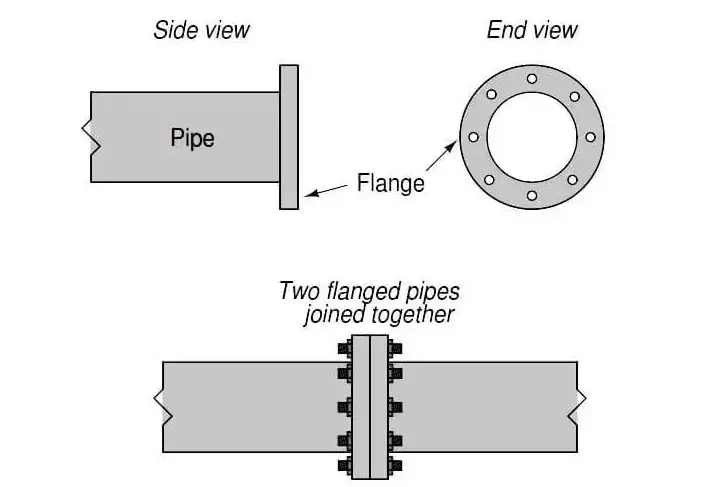In the realm of piping systems, the selection of appropriate joint types is paramount to ensure structural integrity, leak prevention, and ease of maintenance. Two prevalent types of pipe joints are welded and flanged joints. Understanding the distinctions between these joint types is crucial for engineers, designers, and maintenance personnel involved in the planning, installation, and upkeep of piping systems.

1. Welded Joints
Definition:
Welded joints involve the fusion of two pipe sections using heat and filler material, creating a continuous, seamless connection. This process eliminates the need for additional sealing components.
Types of Welded Joints:
-
Butt Welds: The ends of two pipes are aligned and welded together.
-
Socket Welds: One pipe is inserted into another and welded around the joint.
-
Fillet Welds: Used for joining pipes at right angles.
Advantages:
-
Strength and Durability: Welded joints provide a robust connection, capable of withstanding high pressures and temperatures.
-
Leak Prevention: The absence of gaskets or bolts reduces the potential for leaks.
-
Streamlined Flow: The smooth interior surface minimizes flow resistance and turbulence.
Disadvantages:
-
Labor-Intensive: Welding requires skilled labor and specialized equipment.
-
Limited Flexibility: Once welded, the joint is permanent, making modifications challenging.
-
Inspection Challenges: Welded joints may require advanced techniques for internal inspection.
Applications:
Welded joints are commonly used in high-pressure systems, such as oil and gas pipelines, chemical processing plants, and power generation facilities.
2. Flanged Joints
Definition:
Flanged joints consist of two flanges bolted together, with a gasket between them to ensure a tight seal. This design allows for easy assembly and disassembly.
Components:
-
Flanges: Flat discs with holes for bolts.
-
Gaskets: Sealing materials placed between flanges.
-
Bolts and Nuts: Fasteners used to secure the flanges together.
Advantages:
-
Ease of Maintenance: Flanged joints can be easily disassembled for inspection and repair.
-
Versatility: Suitable for a wide range of pressures and temperatures.
-
Flexibility: Allow for alignment adjustments during installation.
Disadvantages:
-
Potential for Leaks: Gaskets may degrade over time, leading to leaks.
-
Space Requirements: Flanged joints require more space due to the size of flanges and bolts.
-
Higher Cost: The need for additional components can increase costs.
Applications:
Flanged joints are widely used in systems where regular maintenance is necessary, such as water treatment plants, HVAC systems, and food processing industries.
3. Comparative Analysis
| Feature | Welded Joints | Flanged Joints |
|---|---|---|
| Strength | High; suitable for high-pressure systems | Moderate; depends on gasket integrity |
| Leak Resistance | Excellent; no gaskets required | Good; relies on gasket quality |
| Maintenance | Challenging; requires cutting and welding | Easy; can be disassembled |
| Installation Time | Longer; requires skilled labor | Shorter; less specialized labor needed |
| Cost | Generally lower material cost | Higher due to additional components |
| Flexibility | Low; permanent connection | High; allows for alignment adjustments |
4. Considerations for Selection
When choosing between welded and flanged joints, consider the following factors:
-
System Pressure and Temperature: High-pressure systems may benefit from the strength of welded joints, while flanged joints can accommodate varying pressures.
-
Maintenance Requirements: If frequent disassembly is anticipated, flanged joints may be more suitable.
-
Space Constraints: Welded joints require less space, which can be advantageous in compact installations.
-
Budget: Consider both initial installation costs and long-term maintenance expenses.
5. Conclusion
Both welded and flanged joints have distinct advantages and are suitable for different applications. Welded joints offer strength and leak resistance, making them ideal for high-pressure systems. Flanged joints provide ease of maintenance and flexibility, suitable for systems requiring regular inspection and modification. The choice between the two should be based on specific system requirements, including pressure, temperature, maintenance needs, and budget considerations.
Frequently Asked Questions (FAQs)
1. What are the primary differences between welded and flanged joints?
Welded joints involve the fusion of two pipe sections, creating a seamless and permanent connection. Flanged joints consist of two flanges bolted together with a gasket in between, allowing for easy disassembly. The primary differences lie in strength, maintenance requirements, and flexibility.
2. In what applications are welded joints preferred over flanged joints?
Welded joints are preferred in high-pressure systems, such as oil and gas pipelines, where strength and leak resistance are critical. They are also suitable for applications where space constraints make flanged joints impractical.
3. Can flanged joints be used in high-pressure systems?
Yes, flanged joints can be used in high-pressure systems, provided that appropriate flanges and gaskets are selected to match the pressure requirements. Regular maintenance is essential to ensure gasket integrity and prevent leaks.
4. How does the installation process differ between welded and flanged joints?
Welded joints require the use of heat and filler material to fuse two pipe sections, necessitating skilled labor and specialized equipment. Flanged joints involve bolting two flanges together with a gasket in between, a process that is generally quicker and requires less specialized labor.
5. Are there hybrid solutions that combine welded and flanged joints?
Yes, hybrid solutions exist where welded joints are used for the majority of the piping system, and flanged joints are employed at strategic locations, such as at equipment interfaces or where future modifications may be necessary. This approach combines the strengths of both joint types.

